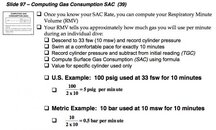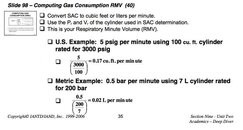- Messages
- 93,416
- Reaction score
- 91,688
- Location
- On the Fun Side of Trump's Wall
- # of dives
- 2500 - 4999
Couple of problems with the article.
Actually it can't be described in psi because that varies with the tank capacity and working pressure. Volume is constant.
Nope. SAC is volume of air breathed at surface at rest per minute. RMV is the actual volume of air breathed per minute on a single dive. It is specific to that dive and varies depending on a rather large number of factors.
Here again you are confusing SAC with RMV. SAC is a number and is unrelated to air breathed during a dive. SAC is volume of air breathed at surface at rest per minute. SAC usually remains nearly the same for a diver over time, again varying somewhat with fitness and a number of other factors. However it doesn't vary nearly as much as RMV over a number of dives. RMV is dive related. SRMV (raw, average, and deep) are values that are calculated from RMV and depth (for average and deep) describing what the air used during the dive would equate to had it been breathed at the surface.
Sorry to be pedantic - but there is way more than enough confusion relating to SAC, RMV, and SRMV (Surface Respiratory Mninute Volume).
Actually what you've done is take a couple sentences out of context for the purpose of creating an argument about them ... and all it proves is that on ScubaBoard some people will find a way to create an argument out of anything.
FWIW - that article's made the rounds, pretty much worldwide, for about a decade now. So far you're the only person I've ever heard express any confusion about the terminology or how it's been used ...
... Bob (Grateful Diver)
---------- Post added April 16th, 2014 at 07:52 AM ----------
Actually, the fact is that a lot of people use the terms in different ways. You may have been taught one use of the term; others have been taught another. In the Dive Planning course I wrote, I talk about this confusion. I point out that SAC rate has come to mean different things because of the way it is used. A lot of people use SAC to mean what other people mean by RMV.
If a diver is always using the same sized tank, it is a lot easier for that diver to think of SAC in terms of PSI. A large percentage of divers have never even seen anything but an AL 80. There is nothing wrong with them thinking of SAC in PSI, as long as they know it will be different should they ever try a different sized tank.
The article explains that SAC, as an expression in PSI, is dependent on the size of the cylinder ... it also gives you a very simple formula that uses both tank size and working pressure to convert from SAC to RMV.
An important concept to consider is that looking at consumption in terms of pressure is useful for tracking actual vs predicted consumption during the dive ... since the only real-time feedback mechanism available to you is your pressure gauge.
Looking at the same consumption rate as an expression of volume (cubic feet per minute) is useful for dive planning, since you know the rated volume of your cylinder (assuming it's filled to its working pressure). Knowing your baseline, or tank factor, is useful for determining how much gas you actually have prior to the dive if it's not at working pressure ... as well as how much gas you actually used during the dive.
This is why it's important to establish terms for gas consumption rate as both pressure per minute and volume per minute, because they're used for different purposes ... the latter for dive planning, the former for tracking real-time use during the dive. What you call them is rather irrelevent, and I've heard many different terms used, both by agencies and individuals. That is why I specified definitions for the way I was using them in the article.
... Bob (Grateful Diver)






